
Dimdima
Online Children's Magazine from India

Dimdima
Online Children's Magazine from India
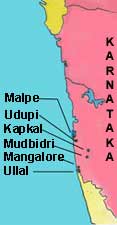
At the mouth of the Malpe or Udyavara river, on the palmfringed Dakshina Kannada coast, lies the port of Malpe. It is the largest fish-curing port in the country.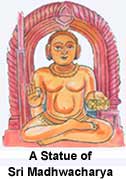
Malpe has a picturesque beach and three rocky islands to its west. One of them, called the Coconut Island, has the Columnar Lava,which is a national geological monument. The rocks which make up these columns were formed as a result of volcanic activity some 60 million years ago.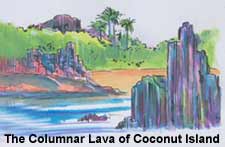 Four kilometres to the south of Malpe is Udipi, the old Rajatapithapura. It is a famous centre of pilgrimage. Madhwacharya, the great Dwaita philosopher and saint, established eight mutts(monasteries) here some 700 years back. There is a temple here with an idol of Krishna which is said to have turned around to give 'darshana' to a low-caste devotee named Kanakadasa.
Four kilometres to the south of Malpe is Udipi, the old Rajatapithapura. It is a famous centre of pilgrimage. Madhwacharya, the great Dwaita philosopher and saint, established eight mutts(monasteries) here some 700 years back. There is a temple here with an idol of Krishna which is said to have turned around to give 'darshana' to a low-caste devotee named Kanakadasa. 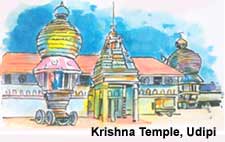
Kanakadasa was a Vaishnava saint and a poet, who was born around 1550 AD. He was a great devotee of Lord Krishna, but as he belonged to the lowly Kuruba caste, he was not only barred from entering the temple but also wasn't allowed to stand outside the temple's main entrance. He cried out in anguish to the Lord, who is said to have turned his head so that his devotee could see him through a little window at the back. The window has been called , Kanakana Kindi, Kanaka's window, ever since.
Lakhs of devotees visit this temple, especially during the 'Paryayotsava', a colourful festival held once in two years.
Udipi is also an important educational and banking centre.
Udyavara, four kilometres south-west of Udipi, is the birthplace of Madhwacharya. A statue of the saint stands at the spot where he was born.
South of Udipi lie two strongholds of Jainism - Karkala and Mudbidri. Karkala is famous for its 12.8 - metre - high Gomata statue, installed in 1432 A.D. It is also the hometown of Kamataka's famous sculptor, the late Renjal Gopal Shenoy, the creator of gigantic idols which have been installed, not only in Karnataka and other parts of the country, but also in Japan.
Mudbidri is described as the 'Jaina Kashi'. It has 18 basadis or temples, the biggest of them being the Tribhuvana Tilaka Chudamani basadi, also known as the 'Basadi of a Thousand Pillars'. It has monolithic columns and a priceless collection of metal images of Jaina Tirthankaras, studded with jewels.
The 16th century Kannada poet, Ratnakaravami, is said to have composed his masterpiece, 'Bharatesha Vaibhava' at Mudbidri.
Mangalore, named after the 10th century queen Mangaladevi, lies to the' south of Mudbidri. It was a flourishing port as far back as the 2nd century A.D.
Sericulture, introduced by Tipu Sultan, made Mangalore a leading silk producer in India.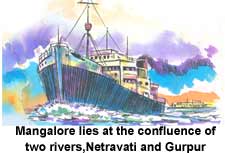
Mangalore is a major centre of higher education in Karnataka. Besides being a commercial and industrial centre, Mangalore is the only major port of Karnataka.
The 760-km-long Konkan Railway, a coastal line now under construction, will join Mangalore with Mumbai. The 41- hour journey from Mangalore to Mumbai will be reduced to 18 hours once this project is completed.
At the southernmost end of the Dakshina Kannada coast, just 8 kilometres south of Mangalore, lies Ullal, famous for its silvery beaches. In the latter half of the 17th century, Ullal was ruled by the fiery queen, Abbakkadevi. When Abbakka became queen, she stopped paying the annual tax to the Portuguese, who were a major power in the region at that time.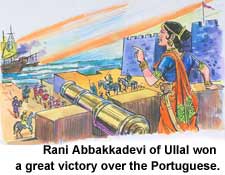 Then, defying a ban on trading with other countries, she sent a fleet of ships to trade with the Arab countries. The Portuguese mounted an attack on Ullal, but urged on by their queen, the soldiers of Ullal fought fiercely and drove the Europeans away.
Then, defying a ban on trading with other countries, she sent a fleet of ships to trade with the Arab countries. The Portuguese mounted an attack on Ullal, but urged on by their queen, the soldiers of Ullal fought fiercely and drove the Europeans away.
Last updated on :2/28/2005
Dimdima is the Sanskrit word for ‘drumbeat’. In olden days, victory in battle was heralded by the beat of drums or any important news to be conveyed to the people used to be accompanied with drumbeats.
Bharatiya Vidya Bhavan
K. M Munshi Marg,
Chowpatty, Mumbai - 400 007
email : editor@dimdima.com
Bharatiya Vidya Bhavan
505, Sane Guruji Marg,
Tardeo, Mumbai - 400 034
email : promo@dimdima.com
Dimdima.com, the Children's Website of Bharatiya Vidya Bhavan launched in 2000 and came out with a Printed version of Dimdima Magazine in 2004. At present the Printed Version have more than 35,000 subscribers from India and Abroad.